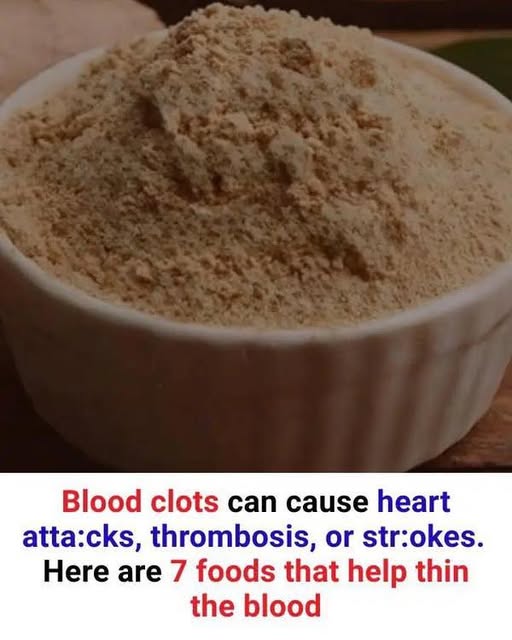Could the Key to Better Heart Health Already Be in Your Kitchen?
Your kitchen might hold more than just your next meal—it could contain the natural tools your body needs to support better blood flow, heart health, and clot prevention.
Each year, thousands of people suffer from heart attacks, strokes, and blood clots—often without prior warning. These events are frequently linked to poor circulation or clot formation, also known as thrombosis. While medications and lifestyle changes play a vital role in prevention, certain foods can help support cardiovascular function in a natural, gentle, and effective way.
Let’s explore the importance of blood circulation, the risks associated with blood clots, and seven everyday foods that can help boost blood flow and reduce the risk of clot formation—naturally and deliciously.
🫀 Why Preventing Blood Clots Matters
Your circulatory system delivers oxygen and nutrients to every cell in your body. But when blood clots form in your veins or arteries, they can block that flow—leading to life-threatening events such as:
- Strokes
- Heart attacks
- Deep vein thrombosis (DVT)
- Pulmonary embolism
Clots can be caused by a number of factors, including:
- Chronic inflammation
- Obesity or diabetes
- Cancer
- Smoking
- Sedentary lifestyle
- Long periods of immobility (e.g., flights or bed rest)
- Natural aging
While prescription blood thinners can be effective, many people prefer a preventive, food-based approach when possible—especially when combined with healthy habits like movement, hydration, and stress management.
🍎 7 Natural Blood-Flow Boosting Foods
1. Garlic
Garlic isn’t just a kitchen staple—it’s a powerful natural blood thinner.
- Contains allicin, a sulfur compound that promotes heart health
- Helps reduce blood pressure and cholesterol
- May prevent platelet aggregation, a key step in clot formation
How to use it: Add raw or lightly cooked garlic to salad dressings, soups, or roasted vegetables.
2. Turmeric
This golden spice contains curcumin, a compound with strong anti-inflammatory and anti-coagulant properties.
- May reduce inflammation in blood vessels
- Helps prevent abnormal blood clotting
- Supports arterial flexibility
How to use it: Stir turmeric into teas, smoothies, soups, or golden milk lattes. Combine with black pepper for better absorption.
3. Cayenne Pepper
Cayenne pepper contains capsaicin, which not only gives it heat but also helps improve circulation.
- Promotes healthy blood flow
- Prevents clot formation by reducing blood platelet stickiness
- Supports cardiovascular health
How to use it: Sprinkle over eggs, stir into sauces, or add to detox drinks for a metabolism-boosting kick.
4. Fatty Fish (like Salmon, Mackerel, and Sardines)
Rich in omega-3 fatty acids, these fish help thin the blood and support heart health.
- Reduce inflammation and triglycerides
- Lower the risk of atherosclerosis and clotting
- Improve the elasticity of blood vessels
How to use it: Enjoy grilled salmon, baked mackerel, or canned sardines with olive oil for a heart-smart meal.
5. Berries (Blueberries, Strawberries, Raspberries)
Berries are rich in antioxidants and flavonoids, which support healthy blood vessels.
- May reduce oxidative stress and inflammation
- Improve blood vessel function
- May help prevent clot-related stroke
How to use it: Add to oatmeal, yogurt, smoothies, or eat as a fresh snack.
6. Dark Chocolate (70% cocoa or higher)
Yes, chocolate can be heart-healthy—when it’s the dark kind.
- Contains flavanols that improve circulation
- Helps lower blood pressure and reduce clotting risk
- Boosts nitric oxide, which helps dilate blood vessels
How to use it: Enjoy a small piece of dark chocolate daily, or use in healthy dessert recipes.
7. Leafy Greens (Spinach, Kale, Swiss Chard)
Loaded with vitamin K, nitrates, and fiber, leafy greens support circulation and arterial health.
- Nitrates help relax blood vessels
- May improve blood pressure and flow
- High fiber helps reduce inflammation and cholesterol
How to use it: Toss into smoothies, sauté as a side, or use as a base for salads and grain bowls.
💧 Bonus Tips for Better Blood Flow
In addition to including these foods in your diet, there are simple daily habits that can help your body maintain optimal circulation:
- Stay hydrated – Water thins the blood naturally
- Move regularly – Walking, stretching, and gentle cardio boost circulation
- Limit processed foods and sugars – They promote inflammation and clotting
- Avoid smoking – A major risk factor for clot formation
- Reduce stress – Chronic stress can constrict blood vessels and elevate risk
⚠️ When to See a Doctor
While food can support your heart and vascular health, it’s important to remember that natural remedies should never replace professional medical care. If you have a history of blood clots, heart disease, or are taking blood-thinning medications, consult your doctor before significantly changing your diet.
📌 Final Thoughts: Let Food Be Your First Line of Defense
Nature has provided us with incredible tools to support our bodies—and some of the most powerful ones are already in your kitchen. By making smart dietary choices, you can boost circulation, reduce clot risk, and protect your heart for the long haul.
Adding garlic to your soup, tossing berries into your yogurt, or enjoying a square of dark chocolate can be more than just tasty—it can be part of your daily heart health routine.
💬 What are your favorite heart-healthy foods? Share your thoughts below, or tag us on Instagram @YourHealthBlog with your best blood-boosting recipes!
